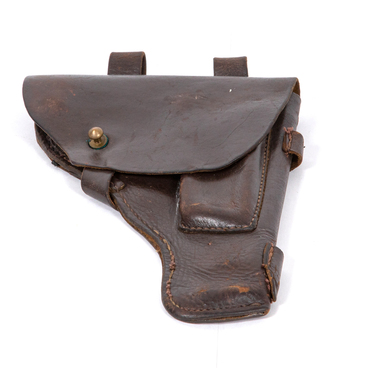The German flask, displayed in the Museum Resource Center, was produced in 1941 based on the 1931 design. It was made of uncolored aluminum. The flask is flat, has a rounded shape. To make it more convenient to wear on the hip, a small dent was made on the flask wall. There is another indentation on the bottom which makes it more stable.
The kit consisted of the flask and the felt case for storage. Two halves of the case were stitched together and the seam was additionally reinforced with a braid. Thus, the flask could be worn on a waist belt. A narrow leather strap with a carabiner was attached to the case. The flask closed with a metal relief cap and a rubber gasket. So that the soldier would not lose the cap, it was fixed on the strap of a vertical leather fastening belt, which was attached to the case.
Since 1942, the design of the case was simpler, and the strap was made of cheaper leather. Over time, it was replaced with tarpaulin straps, and the number of buttons on the case was reduced from four to three.
The flasks of later models were made of painted and unpainted steel; woven cases painted in different colors (for instance, green and gray) were used for them. Some flasks were made of dark brown or brown plastic with Bakelite caps and cups.
For the units stationed on the Eastern Front, manufacturers produced flasks covered with spotted dark brown or brown phenol formaldehyde-based resins, which protected the liquid from frost. The caps were made of the same material. Soldiers of the German African Corps were supplied with wooden flasks.
Although the Wehrmacht equipment in World War II was standardized, even within the same military unit, the flasks were different. During battles, they, like other equipment items, were damaged by bullets and shell fragments. If a soldier could not get a new flask to replace the damaged one, he would try to quickly fix the old one, or try to buy a new one or get a captured flask.
In addition to the standard ones, Wehrmacht soldiers used the flasks of the Hitler Youth, old Reichswehr bottles (Weimar Republic Army), as well as various civilian models donated by volunteer organizations. At the end of 1944, the Nazi army attempted to establish an official design for the equipment, but by that time it no longer made sense — the war was lost.
The kit consisted of the flask and the felt case for storage. Two halves of the case were stitched together and the seam was additionally reinforced with a braid. Thus, the flask could be worn on a waist belt. A narrow leather strap with a carabiner was attached to the case. The flask closed with a metal relief cap and a rubber gasket. So that the soldier would not lose the cap, it was fixed on the strap of a vertical leather fastening belt, which was attached to the case.
Since 1942, the design of the case was simpler, and the strap was made of cheaper leather. Over time, it was replaced with tarpaulin straps, and the number of buttons on the case was reduced from four to three.
The flasks of later models were made of painted and unpainted steel; woven cases painted in different colors (for instance, green and gray) were used for them. Some flasks were made of dark brown or brown plastic with Bakelite caps and cups.
For the units stationed on the Eastern Front, manufacturers produced flasks covered with spotted dark brown or brown phenol formaldehyde-based resins, which protected the liquid from frost. The caps were made of the same material. Soldiers of the German African Corps were supplied with wooden flasks.
Although the Wehrmacht equipment in World War II was standardized, even within the same military unit, the flasks were different. During battles, they, like other equipment items, were damaged by bullets and shell fragments. If a soldier could not get a new flask to replace the damaged one, he would try to quickly fix the old one, or try to buy a new one or get a captured flask.
In addition to the standard ones, Wehrmacht soldiers used the flasks of the Hitler Youth, old Reichswehr bottles (Weimar Republic Army), as well as various civilian models donated by volunteer organizations. At the end of 1944, the Nazi army attempted to establish an official design for the equipment, but by that time it no longer made sense — the war was lost.


